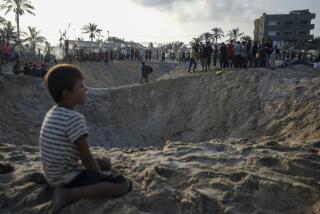Cambodian Accord Imperiled by Continued Fighting : Asia: Guerrilla, government forces battle in a strategic region as big U.N. peacekeeping mission gets under way.
- Share via
KOMPONG THOM, Cambodia — The muffled thud of artillery shells shatters the afternoon tranquillity in this northern Cambodian town, fresh evidence that a cease-fire in Cambodia’s civil war is still an elusive goal a week after the United Nations began a major deployment in the country.
Four people were wounded when the shells fell close to Kompong Thom, 125 miles north of Phnom Penh, on Friday night. It was the closest the fighting has come to this northern provincial capital in nearly two years.
The shells were believed to have been fired by forces loyal to the Khmer Rouge, the hard-line guerrilla faction that is feared by many Cambodians because of its history of brutal tyranny in the 1970s. Now, with the slow encirclement of Kompong Thom, the Khmer Rouge has the capacity to damage a delicate peace process that began with the signing of a 19-nation peace agreement in Paris last year.
Un Ning, governor of this province, said in an interview that heavy fighting between Cambodian government forces and the Khmer Rouge has been raging 20 miles north of Kompong Thom near the village of Sala Visay, where guerrillas burned 10 homes, and about 15 miles to the northwest at the town of Banteay Stong.
Un Ning said that 3,347 people have been displaced by the fighting and now live in refugee camps.
“The Khmer Rouge wants to take all of this area before the United Nations comes,” Un Ning said. “When they have this area, they can have people. When they have people, they can win an election.”
What role the United Nations should play has become a burning issue, not only in this province but in Phnom Penh.
Last Sunday, a Japanese civil servant named Yasushi Akashi arrived in Phnom Penh as head of the U.N. Transitional Authority in Cambodia, which is billed as the largest peacekeeping operation in the history of the world organization, with an estimated 22,000 troops and civilian advisers and a price tag of $2 billion.
But with fighting raging in Kompong Thom province, there are only seven U.N. soldiers present--a major from Algeria, assisted by officers from Tunisia and Indonesia and four Australian communications technicians. They have been here since November as part of an interim U.N. force preparing for the full deployment.
Akashi and his military commander, Gen. John Sanderson of Australia, face a difficult dilemma: Should they immediately dispatch a battalion of Indonesian special forces to Kompong Thom to enforce the peace or wait until all four sides agree to a cease-fire?
A diplomat who follows the issue closely said it is unthinkable that the United Nations would commit peacekeeping troops before the parties stop shooting, although French Gen. Jean-Michel Loridon, the second in command, has told reporters that the United Nations should be prepared to accept “significant casualties” to ensure the peace. Kompong Thom is the only area in Cambodia where heavy fighting is taking place at the moment. This is something of a puzzle, because the Khmer Rouge is adhering to the cease-fire elsewhere in the country.
One theory had held that the fighting was merely jockeying for position before the arrival of the United Nations in Cambodia. But UNTAC is now here and the fighting goes on. Significantly, the Khmer Rouge also has refused to send a military liaison officer to Kompong Thom until UNTAC troops are fully deployed here. The other two guerrilla groups that signed the peace accord have had liaison officers here since January.
“Kompong Thom is the center of the country,” explained Col. Chea Khemara, liaison officer of the Kampuchean People’s National Liberation Front, a pro-Western guerrilla group. “If the Khmer Rouge can hold this area, it can cut off supplies to both the north and the west. They can control the whole country.”
Khemara also noted that Kompong Thom has a special significance to the Khmer Rouge. It is the birthplace of Pol Pot, the man who ruled Cambodia from 1975 to 1979 and who is believed to head the Khmer Rouge in the jungle. It is also the birthplace of the wife of Khieu Samphan, the white-haired economist who serves as the public leader of the group.
One military officer said that the Khmer Rouge now has four divisions in Kompong Thom province and one division stationed near strategic Highway 6, which is the main road south to Phnom Penh.
“They don’t need to capture the city, but to harass it and cut off the roads,” said the officer. “They control not only one province but all the others that get supplies through Kompong Thom.”
More to Read
Sign up for Essential California
The most important California stories and recommendations in your inbox every morning.
You may occasionally receive promotional content from the Los Angeles Times.













